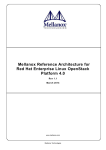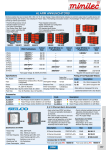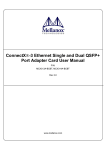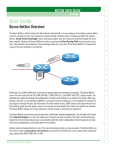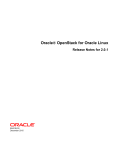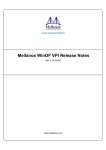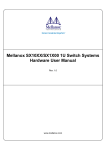Download Mellanox OpenStack and SDN/OpenFlow Solution Reference
Transcript
Mellanox OpenStack and SDN/OpenFlow
Solution Reference Architecture
Rev 1.2
September 2013
www.mellanox.com
Mellanox Technologies
NOTE:
THIS HARDWARE, SOFTWARE OR TEST SUITE PRODUCT (“PRODUCT(S)”) AND ITS RELATED DOCUMENTATION ARE
PROVIDED BY MELLANOX TECHNOLOGIES “AS-IS” WITH ALL FAULTS OF ANY KIND AND SOLELY FOR THE PURPOSE OF
AIDING THE CUSTOMER IN TESTING APPLICATIONS THAT USE THE PRODUCTS IN DESIGNATED SOLUTIONS. THE
CUSTOMER'S MANUFACTURING TEST ENVIRONMENT HAS NOT MET THE STANDARDS SET BY MELLANOX
TECHNOLOGIES TO FULLY QUALIFY THE PRODUCT(S) AND/OR THE SYSTEM USING IT. THEREFORE, MELLANOX
TECHNOLOGIES CANNOT AND DOES NOT GUARANTEE OR WARRANT THAT THE PRODUCTS WILL OPERATE WITH THE
HIGHEST QUALITY. ANY EXPRESS OR IMPLIED WARRANTIES, INCLUDING, BUT NOT LIMITED TO, THE IMPLIED
WARRANTIES OF MERCHANTABILITY, FITNESS FOR A PARTICULAR PURPOSE AND NON INFRINGEMENT ARE
DISCLAIMED. IN NO EVENT SHALL MELLANOX BE LIABLE TO CUSTOMER OR ANY THIRD PARTIES FOR ANY DIRECT,
INDIRECT, SPECIAL, EXEMPLARY, OR CONSEQUENTIAL DAMAGES OF ANY KIND (INCLUDING, BUT NOT LIMITED TO,
PAYMENT FOR PROCUREMENT OF SUBSTITUTE GOODS OR SERVICES; LOSS OF USE, DATA, OR PROFITS; OR BUSINESS
INTERRUPTION) HOWEVER CAUSED AND ON ANY THEORY OF LIABILITY, WHETHER IN CONTRACT, STRICT LIABILITY,
OR TORT (INCLUDING NEGLIGENCE OR OTHERWISE) ARISING IN ANY WAY FROM THE USE OF THE PRODUCT(S) AND
RELATED DOCUMENTATION EVEN IF ADVISED OF THE POSSIBILITY OF SUCH DAMAGE.
Mellanox Technologies
350 Oakmead Parkway Suite 100
Sunnyvale, CA 94085
U.S.A.
www.mellanox.com
Tel: (408) 970-3400
Fax: (408) 970-3403
Mellanox Technologies, Ltd.
Beit Mellanox
PO Box 586 Yokneam 20692
Israel
www.mellanox.com
Tel: +972 (0)74 723 7200
Fax: +972 (0)4 959 3245
© Copyright 2013. Mellanox Technologies. All Rights Reserved.
Mellanox®, Mellanox logo, BridgeX®, ConnectX®, CORE-Direct®, InfiniBridge®, InfiniHost®, InfiniScale®,
MLNX-OS®, PhyX®, SwitchX®, UFM®, Virtual Protocol Interconnect® and Voltaire® are registered trademarks of Mellanox Technologies,
Ltd.
Connect-IB™, FabricIT™, Mellanox Open Ethernet™, Mellanox Virtual Modular Switch™, MetroX™, MetroDX™, ScalableHPC™,
Unbreakable-Link™ are trademarks of Mellanox Technologies, Ltd.
All other trademarks are property of their respective owners
2
Document Number:
Mellanox Technologies
Mellanox OpenStack and SDN/OpenFlow Solution Reference Architecture
Rev 1.2
Contents
1
Solution Overview ........................................................................................................................... 7
1.1
OpenStack .............................................................................................................................. 7
1.2
Software Defined Networking (SDN) ...................................................................................... 9
1.2.1
OpenFlow................................................................................................................ 10
1.2.2
Supported Features ................................................................................................ 11
2
Accelerating Storage .................................................................................................................... 12
3
Network Virtualization on Mellanox Adapters ............................................................................ 14
4
5
3.1
Performance Measurements ................................................................................................ 15
3.2
Quality of Service Considerations ........................................................................................ 15
3.3
Seamless Integration ............................................................................................................ 17
Setup and Installation ................................................................................................................... 18
4.1
Basic Setup........................................................................................................................... 18
4.2
Hardware Requirements ....................................................................................................... 18
4.3
Software Requirements ........................................................................................................ 19
4.4
Prerequisites ......................................................................................................................... 19
4.5
OpenStack Software installation........................................................................................... 19
4.6
OpenFlow Agent Installation................................................................................................. 20
Setting Up the Network ................................................................................................................ 21
5.1
5.2
5.3
Configuration Examples ....................................................................................................... 21
5.1.1
Creating a Network ................................................................................................. 21
5.1.2
Creating a Para-Virtualized vNIC Instance ............................................................. 22
5.1.3
Creating an SR-IOV Instance ................................................................................. 23
5.1.4
Creating a Volume .................................................................................................. 24
5.1.5
Attach a Volume ..................................................................................................... 25
Verification Examples ........................................................................................................... 26
5.2.1
Instances Overview ................................................................................................ 26
5.2.2
Connectivity Check ................................................................................................. 26
5.2.3
Volume Check ........................................................................................................ 26
OpenFlow Configuration Examples ...................................................................................... 27
5.3.1
Drop SSH Traffic from a Given Source IP Address ................................................ 27
5.3.2
Set QoS Egress Queue .......................................................................................... 28
3
Mellanox Technologies
Rev 1.2
Solution Overview
List of Figures
Figure 1: Mellanox OpenStack Architecture ............................................................................................ 8
Figure 2: OpenFlow Architecture ........................................................................................................... 11
Figure 3: OpenStack Based IaaS Cloud POD Deployment Example ................................................... 12
Figure 4: RDMA Acceleration ................................................................................................................ 13
Figure 5: eSwitch Architecture............................................................................................................... 14
Figure 6: Latency Comparison .............................................................................................................. 15
Figure 7: QoS, Setup Example .............................................................................................................. 16
Figure 8: QoS, Test Results .................................................................................................................. 16
Figure 9: Network Virtualization............................................................................................................. 17
Figure 10: Mellanox MCX314A-BCBT, ConnectX-3 40GbE Adapter ................................................... 18
Figure 11: Mellanox SX1036, 36x40GbE .............................................................................................. 19
Figure 12: Mellanox 40GbE, QSFP Copper Cable ............................................................................... 19
Figure 13: Quantum net-create/subnet-create Commands ................................................................... 21
Figure 14: OpenStack Dashboard, Instances ....................................................................................... 22
Figure 15: OpenStack Dashboard, Launch Instance ............................................................................ 22
Figure 16: OpenStack Dashboard, Launch Interface – Select Network................................................ 23
Figure 17: Quantum port-create Command .......................................................................................... 23
Figure 18: Using the nova boot Command............................................................................................ 24
Figure 19: OpenStack Dashboard, Volumes ......................................................................................... 24
Figure 20: OpenStack Dashboard, Create Volumes ............................................................................. 24
Figure 21: OpenStack Dashboard, Volumes ......................................................................................... 25
Figure 22: OpenStack Dashboard, Manage Volume Attachments ....................................................... 25
Figure 23: VM Overview ........................................................................................................................ 26
Figure 24: Remote Console Connectivity .............................................................................................. 26
Figure 25: OpenStack Dashboard, Volumes ......................................................................................... 26
Figure 26: OpenStack Dashboard, Console.......................................................................................... 27
4
Mellanox Technologies Confidential
Mellanox OpenStack and SDN/OpenFlow Solution Reference Architecture
Rev 1.2
Preface
About this Document
This reference design presents the value of using Mellanox interconnect products and
describes how to integrate the OpenStack /OpenFlow solution with the end-to-end Mellanox
interconnect products.
Audience
This reference design is intended for server and network administrators.
The reader must have experience with the basic OpenStack framework and installation.
References
For additional information, see the following documents:
Table 1: Related Documentation
Reference
Location
Mellanox OFED User Manual
www.mellanox.com > Products > Adapter IB/VPI SW > Linux
SW/Drivers
http://www.mellanox.com/content/pages.php?pg=products_dy
n&product_family=26&menu_section=34
Mellanox software source packages
https://github.com/mellanox-openstack
OpenStack Website
www.openstack.org
Mellanox OpenStack wiki page
https://wiki.openstack.org/wiki/Mellanox-OpenStack
Mellanox approved cables
http://www.mellanox.com/related-docs/user_manuals/Mellan
ox_approved_cables.pdf
Mellanox Ethernet Switch Systems
User Manual
http://www.mellanox.com/related-docs/user_manuals/SX10X
X_User_Manual.pdf
Mellanox Ethernet adapter cards
http://www.mellanox.com/page/ethernet_cards_overview
Solutions space on Mellanox
community
http://community.mellanox.com/community/support/solutions
OpenFlow RPM package
http://community.mellanox.com/docs/DOC-1188
5
Mellanox Technologies
Rev 1.2
Solution Overview
Reference
Location
OpenStack RPM package
http://community.mellanox.com/docs/DOC-1187
Mellanox eSwitchd Installation for
OpenFlow and OpenStack
http://community.mellanox.com/docs/DOC-1126
Troubleshooting
http://community.mellanox.com/docs/DOC-1127
Mellanox OFED Driver Installation
and Configuration for SR-IOV
http://community.mellanox.com/docs/DOC-1317
6
Mellanox Technologies Confidential
Mellanox OpenStack and SDN/OpenFlow Solution Reference Architecture
1
Solution Overview
1.1
OpenStack
Rev 1.2
Deploying and maintaining a private or public cloud is a complex task, with various vendors
developing tools to address the different aspects of the cloud infrastructure, management,
automation, and security. These tools tend to be expensive and create integration challenges
for customers when they combine parts from different vendors. Traditional offerings suggest
deploying multiple network and storage adapters to run management, storage, services, and
tenant networks. These also require multiple switches, cabling, and management
infrastructure, which increases both up front and maintenance costs.
Other, more advanced offerings provide a unified adapter and first level ToR switch, but still
run multiple and independent core fabrics. Such offerings tend to suffer from low throughput
because they do not provide the aggregate capacity required at the edge or in the core; and
because they deliver poor application performance due to network congestion and lack of
proper traffic isolation.
Several open source “cloud operating system” initiatives have been introduced to the market,
but none has gained sufficient momentum to succeed. Recently OpenStack has managed to
establish itself as the leading open source cloud operating system, with wide support from
major system vendors, OS vendors, and service providers. OpenStack allows central
management and provisioning of compute, networking, and storage resources, with
integration and adaptation layers allowing vendors and/or users to provide their own plug-ins
and enhancements.
Mellanox Technologies offers seamless integration between its products and OpenStack
layers and provides unique functionality that includes application and storage acceleration,
network provisioning, automation, hardware-based security, and isolation. Furthermore, using
Mellanox interconnect products allows cloud providers to save significant capital and
operational expenses through network and I/O consolidation and by increasing the number of
virtual machines (VMs) per server.
Mellanox provides a variety of network interface cards (NICs) supporting one or two ports of
10GbE, 40GbE, or 56Gb/s InfiniBand. These adapters simultaneously run management,
network, storage, messaging, and clustering traffic. Furthermore, these adapters create virtual
domains within the network that deliver hardware-based isolation and prevent cross-domain
traffic interference.
In addition, Mellanox Virtual Protocol Interconnect (VPI) switches deliver the industry’s most
cost-effective and highest capacity switches (supporting up to 36 ports of 56Gb/s). When
deploying large-scale, high-density infrastructures, leveraging Mellanox converged network
VPI solutions translates into fewer switching elements, far fewer optical cables, and simpler
network design.
7
Mellanox Technologies
Rev 1.2
Solution Overview
Mellanox integration with OpenStack provides the following benefits:
•
Cost-effective and scalable infrastructure that consolidates the network and storage to a
highly efficient flat fabric, increases the VM density, commoditizes the storage
infrastructure, and linearly scales to thousands of nodes
•
Delivers the best application performance with hardware-based acceleration for
messaging, network traffic, and storage
•
Easy to manage via standard APIs. Native integration with OpenStack Quantum (network)
and Cinder (storage) provisioning APIs
•
Provides tenant and application security/isolation, end-to-end hardware-based traffic
isolation, and security filtering
Figure 1: Mellanox OpenStack Architecture
8
Mellanox Technologies Confidential
Mellanox OpenStack and SDN/OpenFlow Solution Reference Architecture
1.2
Rev 1.2
Software Defined Networking (SDN)
Software Defined Networking (SDN) is emerging as an alternative to proprietary data center
networks. SDN architecture separates the control plane from the data plane in data center
switches and hosts. With SDN, network control is implemented in software and can be
executed from a server, which reduces network complexity and provides a common interface
as an alternative to the proprietary and expensive options from traditional vendors. At the basis
of the SDN approach is the decoupling of the system that makes decisions as to where traffic is
sent (the control plane) from the underlying system that forwards traffic to the selected
destination (the data plane). This enables network architects programmatically deciding how
traffic flows throughout the network and centralizing this logic into a programmable interface
that can be extended and tailored to customer needs.
SDN Approach Benefits
•
Efficient and flexible networks (tailored optimization)
•
Quick time-to-market of new services
•
Cost savings on hardware (simpler forwarding devices required)
•
Ability to test and implement new routing protocols quickly
Mellanox Technologies has been implementing these concepts for over 10 years in its
InfiniBand products, providing existing data centers with a mature infrastructure for flexible,
scalable, and dynamic networks. Today, Mellanox takes the extensive knowledge gained from
building hundreds of high performance and scalable InfiniBand networks, and provides SDN
networks on Ethernet as well, utilizing state-of-the-art technologies such as
OpenFlow-enabled NICs and switches and an open architecture.
Mellanox's solution for SDN networks is built as an open, industry-standard platform which
can deliver a wide range of Network Applications.
Mellanox integration with SDN/OpenFlow provides the following benefits:
•
Maximum Performance
Mellanox embedded eSwitch technology on its 40GbE NICs, together with an
OpenFlow agent, provides the scalability and performance required for SDN security
solutions. The eSwitch functionality enables hypervisor-like functionality in hardware
while connecting with SR-IOV. This allows the customer to benefit from both worlds:
policy enforcement via OpenFlow protocol and SR-IOV accelerated performance
mode. A VM can access the network directly and execute the desired policy at
near-line-rate performance.
See Network Virtualization on Mellanox Adapters in chapter 3 of this document for
more information on eSwitch.
9
Mellanox Technologies
Rev 1.2
Solution Overview
•
OpenStack and OpenFlow seamless integration
Mellanox implements advanced provisioning logic to translate cloud service-level
definitions and requirements to network provisioning commands. Mellanox supports
the latest OpenStack release and utilizes industry-standard protocol Quantum API to
integrate the Open Stack cloud management platform and Mellanox network devices.
Both OpenStack and OpenFlow applications use the same eSwitch component on the
ConnectX-3 adapter.
•
Overlay networks support
Mellanox customers are now able to benefit from the VxLAN and NVGRE scalability
performance without compromising on network performance. ConnectX-3 supports
high-performance 10GbE and 40GbE VxLAN and NVGRE. ConnectX-3 Pro
eliminates the VxLAN and NVGRE performance overheads. It dramatically reduces
CPU overhead up to 80% and enables 10GbE and 40GbE configuration with no
throughput penalty. For additional information, see the ConnectX-3 Pro page on the
Mellanox website.
•
Partnerships
Mellanox SDN is already enhancing partner solutions by eliminating traditional
performance and scalability limitations.
OpenFlow
1.2.1
OpenFlow protocol provides a standard API between the control plane and forwarding plane.
ConnectX-3 incorporates an embedded switch (eSwitch) enabling VM communication to
enjoy bare metal performance.
The ConnectX-3 driver includes OpenFlow agent software, based on the Indigo2 open source
project, which enables controlling the eSwitch using standard OpenFlow protocol (the current
OpenFlow version supported is 1.0).
Installing fabric flows on adapter eSwitches has great value and allows networks to scale
naturally. Each eSwitch is responsible only for a relatively few VMs (only those VMs running
on a specific host). Therefore, by distributing these switches on many adapters the scaling
obstacle are eliminated. This is unlinke the case of trying to implement scalability on
centralized physical switches which can support only relatively small numberof flows.
10
Mellanox Technologies Confidential
Mellanox OpenStack and SDN/OpenFlow Solution Reference Architecture
Rev 1.2
Figure 2: OpenFlow Architecture
Controller
VM
VM
OS
OS
OS
Hypervisor
SR-IOV
OpenFlow
Agent
PV
OpenFlow protocol
OpenFlow
Network Controller
VM
eSwitch
Host
In general, any OpenFlow controller (for example, Floodlight) can be used to interface the
OpenFlow agent on ConnectX-3 adapters as long as the OpenFlow protocol versions are
compatible.
1.2.2
Supported Features
The following OpenFlow Match fields are supported:
•
Destination MAC address
•
VLAN ID
•
Ether Type
•
Source/Destination IP address
•
Source/Destination UDP/TCP port
Notes:
o
Field bitmask is not supported.
o
Destination MAC must be included.
The following OpenFlow Action fields are supported:
•
Drop – providing security
•
Set queue – providing QoS on fabric port, to which egress queue the flow is steered
Flow Counters 1 are currently not supported.
1
Roadmap
11
Mellanox Technologies
Rev 1.2
Accelerating Storage
2
Accelerating Storage
Data centers rely on communication between compute and storage nodes, as compute servers
read and write data from the storage servers constantly. In order to maximize the server’s
application performance, communication between the compute and storage nodes must have
the lowest possible latency, highest possible bandwidth, and lowest CPU utilization.
Figure 3: OpenStack Based IaaS Cloud POD Deployment Example
Storage applications rely on iSCSI over TCP communications protocol stack continuously
interrupt the processor in order to perform basic data movement tasks (packet sequence and
reliability tests, re-ordering, acknowledgements, block level translations, memory buffer
copying, etc). This causes data center applications that rely heavily on storage communication
to suffer from reduced CPU efficiency, as the processor is busy sending data to and from the
storage servers rather than performing application processing. The data path for applications
and system processes must wait in line with protocols such as TCP, UDP, NFS, and iSCSI for
their turn using the CPU. This not only slows down the network, but also uses system
resources that could otherwise have been used for executing applications faster.
Mellanox OpenStack solution extends the Cinder project by adding iSCSI running over
RDMA (iSER). Leveraging RDMA Mellanox OpenStack delivers 6X better data throughput
(for example, increasing from 1GB/s to 5GB/s) and while simultaneously reducing CPU
utilization by up to 80% (see Figure 4).
Mellanox ConnectX®-3 adapters bypass the operating system and CPU by using RDMA,
allowing much more efficient data movement. iSER capabilities are used to accelerate
hypervisor traffic, including storage access, VM migration, and data and VM replication. The
use of RDMA shifts data movement processing to the Mellanox ConnectX-3 hardware, which
provides zero-copy message transfers for SCSI packets to the application, producing
significantly faster performance, lower network latency, lower access time, and lower CPU
overhead. iSER can provide 6X faster performance than traditional TCP/IP based iSCSI. The
iSER protocol unifies the software development efforts of both Ethernet and InfiniBand
communities, and reduces the number of storage protocols a user must learn and maintain.
12
Mellanox Technologies Confidential
Mellanox OpenStack and SDN/OpenFlow Solution Reference Architecture
Rev 1.2
RDMA bypass allows the application data path to effectively skip to the front of the line. Data
is provided directly to the application immediately upon receipt without being subject to
various delays due to CPU load-dependent software queues. This has three effects:
•
There is no waiting, which means that the latency of transactions is incredibly low.
•
Because there is no contention for resources, the latency is deterministic, which is
essential for offering end users a guaranteed SLA.
•
Bypassing the OS, using RDMA results in significant savings in CPU cycles. With a more
efficient system in place, those saved CPU cycles can be used to accelerate application
performance.
In the following diagram, it is clear that by performing hardware offload of the data transfers
using the iSER protocol, the full capacity of the link is utilized to the maximum of the PCIe
limit.
To summarize, network performance is a significant element in the overall delivery of data
center services and benefits from high speed interconnects.Unfortunately the high CPU
overhead associated with traditional storage adapters prevents systems from taking full
advantage of these high speed interconnects. The iSER protocol uses RDMA to shift data
movement tasks to the network adapter and thus frees up CPU cycles that would otherwise be
consumed executing traditional TCP and iSCSI protocols. Hence, using RDMA-based fast
interconnects significantly increases data center application performance levels.
Figure 4: RDMA Acceleration
13
Mellanox Technologies
Rev 1.2
Network Virtualization on Mellanox Adapters
3
Network Virtualization on Mellanox Adapters
Single Root IO Virtualization (SR-IOV) allows a single physical PCIe device to present itself
as multiple devices on the PCIe bus. Mellanox ConnectX®-3 adapters are capable of exposing
up to 127 virtual instances called Virtual Functions (VFs). These virtual functions can then be
provisioned separately. Each VF can be viewed as an additional device associated with the
Physical Function. It shares the same resources with the Physical Function, and its number of
ports equals those of the Physical Function.
SR-IOV is commonly used in conjunction with an SR-IOV enabled hypervisor to provide
virtual machines with direct hardware access to network resources, thereby improving
performance.
Mellanox ConnectX-3 adapters equipped with onboard embedded switch (eSwitch) are
capable of performing layer-2 switching for the different VMs running on the server. Using
the eSwitch will gain even higher performance levels and in addition improve security,
isolation and QoS.
Figure 5: eSwitch Architecture
eSwitch main capabilities and characteristics:
•
Virtual switching: creating multiple logical virtualized networks. The eSwitch offload
engines handle all networking operations up to the VM, thereby dramatically reducing
software overheads and costs.
•
Performance: The switching is handled in hardware, as opposed to other applications that
use a software-based switch. This enhances performance by reducing CPU overhead.
14
Mellanox Technologies Confidential
Mellanox OpenStack and SDN/OpenFlow Solution Reference Architecture
3.1
•
Security: The eSwitch enables network isolation (using VLANs) and anti-MAC spoofing.
In addition, by using OpenFlow ACLs, the eSwitch can be configured to filter undesired
network flows.
•
QoS: The eSwitch supports traffic class management, priority mapping, rate limiting,
scheduling, and shaping configured via OpenFlow. In addition, DCBX control plane can
set Priority Flow Control (PFC) and FC parameters on the physical port.
•
Monitoring: Port counters are supported.
Rev 1.2
Performance Measurements
Many data center applications benefits from low latency network communication while others
require deterministic latency. Using regular TCP connectivity between VMs can create high
latency and unpredictable delay behavior.
Figure 6 shows the dramatic difference (20X improvement) delivered by SR-IOV connectivity
running RDMA compared to para-virtualized vNIC running a TCP stream.
Using the direct connection of the SR-IOV and the ConnectX-3 hardware eliminates the
software processing that adds an unpredictable delay to packet data movement. The result is a
consistently low latency that allows application software to rely on deterministic packet
transfer times.
Figure 6: Latency Comparison
3.2
Quality of Service Considerations
The impact of using QoS and network isolation is tremendous. The following example
compares the various latency and bandwidth levels as a function of the QoS level.
The following test reveals the great advantage that can be achieved using the switch QoS
capability:
Setup characteristics:
15
Mellanox Technologies
Rev 1.2
Network Virtualization on Mellanox Adapters
Streams:
In this test, two types of streams were injected:
•
Blue (Storage stream): High bandwidth TCP stream. Latency is not crucial for such an
application.
•
Green (Messaging stream): Low bandwidth TCP messaging stream. Latency (as measured
by Round Robin test) is crucial for such an application.
QoS levels:
The following QoS levels were tested:
•
Single Queue: both streams use the same ingress queue.
•
Dual Queues with no QoS: each stream has its own ingress queue while both queues have
the same priority level.
•
Dual Queues with QoS enabled: each stream has its own ingress queue while the green
stream is prioritized over the blue stream.
Figure 7: QoS, Setup Example
The test results show the following:
(1) When prioritizing a stream (green) and using dual queues, the low priority stream has a
minor effect on the high priority stream (11.8µsec compared to 10.8µsec in Figure 8).
(2) Bandwidth increases when prioritizing streams (9350GbE), as well as when increasing the
number of queues (9187GbE), compared to regular non-QoS conditions (8934GbE).
(3) The latency difference is dramatically reduced when using QoS (11.8µsec compared to 10548µsec).
Figure 8: QoS, Test Results
* Results are based on 10GbE adapter card
Conclusion:
16
Mellanox Technologies Confidential
Mellanox OpenStack and SDN/OpenFlow Solution Reference Architecture
Rev 1.2
The test results emphasize that consolidation is possible on the same physical port.
Applications that require low latency will not suffer from bandwidth-consuming applications
when using more than one queue and enabling QoS.
3.3
Seamless Integration
The eSwitch configuration is transparent to the OpenStack or OpenFlow controller
administrator. The installed eSwitch daemon on the server is responsible for hiding the
low-level configuration. The administrator will use the standard OpenStack dashboard APIs or
OpenFlow controller REST interface for the fabric management.
Both OpenFlow agent and Quantum agent configures the eSwitch in the adapter card.
Figure 9: Network Virtualization
17
Mellanox Technologies
Rev 1.2
Setup and Installation
4
Setup and Installation
4.1
Basic Setup
The following setup is suggested for small scale applications.
The OpenStack environment should be installed according to the OpenStack installation
guide.
In addition, the following installation changes should be applied:
4.2
•
A Quantum server should be installed with the Mellanox Quantum plugin.
•
A Cinder patch should be applied to the storage servers (for iSER support).
•
Mellanox Quantum agent, eSwitch daemon, and Nova patches should be installed on the
compute notes.
Hardware Requirements
•
Mellanox ConnectX®-3 adapter cards
•
10GbE or 40GbE Ethernet switches
•
Cables required for the ConnectX-3 card (typically using SFP+ connectors for 10GbE or
QSFP connectors for 40GbE)
•
Server nodes should comply with OpenStack requirements.
•
Compute nodes should have SR-IOV capability (BIOS and OS support).
There are many options in terms of adapters, cables, and switches. See www.mellanox.com for
additional options.
Figure 10: Mellanox MCX314A-BCBT, ConnectX-3 40GbE Adapter
18
Mellanox Technologies Confidential
Mellanox OpenStack and SDN/OpenFlow Solution Reference Architecture
Rev 1.2
Figure 11: Mellanox SX1036, 36x40GbE
Figure 12: Mellanox 40GbE, QSFP Copper Cable
4.3
4.4
Software Requirements
•
Supported OS
•
RHEL 6.3 or higher
•
Mellanox OFED 2.0.3 (SR-IOV support) or higher.
•
KVM hypervisor – complying with OpenStack requirements
Prerequisites
(1) The basic setup is physically connected.
•
In order to reduce the number of ports in the network, two different networks can be
mapped to the same physical interface on two different VLANs.
(2) Mellanox OFED 2.0 (SR-IOV enabled) is installed on each of the network adapters.
•
For Mellanox OFED installation refer to Mellanox OFED User Manual (Installation
chapter).
http://www.mellanox.com/page/products_dyn?product_family=26
•
See Mellanox Community –for verification options and adaptation.
http://community.mellanox.com/docs/DOC-1317
(3) The OpenStack packages are installed on all network elements.
(4) EPEL repository is enabled. (http://fedoraproject.org/wiki/EPEL).
4.5
OpenStack Software installation
For Mellanox OpenStack installation, follow the Mellanox OpenStack wiki pages:
19
Mellanox Technologies
Rev 1.2
Setup and Installation
•
Quantum: https://wiki.openstack.org/wiki/Mellanox-Quantum
•
Cinder: https://wiki.openstack.org/wiki/Mellanox-Cinder
For the eSwitch daemon installation, follow the OpenStack wiki pages (part of Mellanox
Quantum):
•
4.6
https://wiki.openstack.org/wiki/Mellanox-Quantum
OpenFlow Agent Installation
The OpenFlow agent installation procedure is defined in the Mellanox Community
(http://community.mellanox.com/docs/DOC-1126).
20
Mellanox Technologies Confidential
Mellanox OpenStack and SDN/OpenFlow Solution Reference Architecture
5
Setting Up the Network
5.1
Configuration Examples
Rev 1.2
Once the installation is completed, it is time to set up the network.
Setting up a network consists of the following steps:
(1) Creating a network
(2) Creating a VM instance. Two types of instances can be created:
a. Para-virtualized vNIC
b. SR-IOV direct path connection
(3) Creating a disk volume
(4) Binding the disk volume to the instance that was just created
5.1.1
Creating a Network
Use the quantum net-create and quantum subnet-create commands to create a
new network and a subnet (‘net3’ in the example).
Figure 13: Quantum net-create/subnet-create Commands
21
Mellanox Technologies
Rev 1.2
Setting Up the Network
5.1.2
Creating a Para-Virtualized vNIC Instance
(1) Using the OpenStack Dashboard, launch an instance (VM) using the Launch Instance
button.
(2) Insert all the required parameters and click Launch.
This operation will create a macvtap interface on top of a Virtual Function (VF).
Figure 14: OpenStack Dashboard, Instances
Figure 15: OpenStack Dashboard, Launch Instance
22
Mellanox Technologies Confidential
Mellanox OpenStack and SDN/OpenFlow Solution Reference Architecture
Rev 1.2
(3) Select the desired network for the vNIC (‘net3’ in the example).
Figure 16: OpenStack Dashboard, Launch Interface – Select Network
5.1.3
Creating an SR-IOV Instance
1. Use the quantum port-create command for the selected network (‘net3’ in the
example) to create a port with ‘vnic_type=hostdev’.
Figure 17: Quantum port-create Command
23
Mellanox Technologies
Rev 1.2
Setting Up the Network
2. Use the nova boot command to launch an instance with the created port attached.
Figure 18: Using the nova boot Command
5.1.4
Creating a Volume
Create a volume using the Volumes tab on the OpenStack dashboard. Click the Create Volume
button.
Figure 19: OpenStack Dashboard, Volumes
Figure 20: OpenStack Dashboard, Create Volumes
24
Mellanox Technologies Confidential
Mellanox OpenStack and SDN/OpenFlow Solution Reference Architecture
Rev 1.2
Figure 21: OpenStack Dashboard, Volumes
5.1.5
Attach a Volume
Attach a volume to the desired instance.
The device name should be /dev/dv<letter>. E.g. “/dev/vdc”
Figure 22: OpenStack Dashboard, Manage Volume Attachments
25
Mellanox Technologies
Rev 1.2
Setting Up the Network
5.2
Verification Examples
5.2.1
Instances Overview
Use the OpenStack Dashboard to view all configured instances.
Figure 23: VM Overview
5.2.2
Connectivity Check
There are many options for checking connectivity between difference instances, one of which
is simply to open a remote console and ping the required host.
To launch a remote console for a specific instance, select the Console tab and launch the
console.
Figure 24: Remote Console Connectivity
5.2.3
Volume Check
To verify that the created volume is attached to a specific instance, click the Volumes tab.
Figure 25: OpenStack Dashboard, Volumes
26
Mellanox Technologies Confidential
Mellanox OpenStack and SDN/OpenFlow Solution Reference Architecture
Rev 1.2
Additionally, run the fdisk command from the instance console to see the volume details.
Figure 26: OpenStack Dashboard, Console
5.3
OpenFlow Configuration Examples
The following examples use the Floodlight 0.9 network controller REST API.
Note: The flow must include a match on the destination MAC of the relevant VM’s vNIC (the
MAC that is assigned to the VF used by the VM).
5.3.1
Drop SSH Traffic from a Given Source IP Address
The following example shows how to apply a block rule for SSH traffic (TCP port 22) with
source-ip IP 192.168.100.1 destined to a Virtual Machine with vNIC MAC 52:54:00:12:83:8e.
The OF_DPID is the identifier of the OpenFlow agent responsible for the HCA/eSwitch.
Perform the following commands on the controller:
# MAC=52:54:00:12:83:8e
# DST_PORT="22"
# OF_IP="172.30.40.171"
# OF_DPID="00:00:aa:bb:cc:dd"
# SRC_IP="192.168.100.1"
# curl -d '{"switch": "'"${OF_DPID}"'", "name":"BLOCK-SSH-sw1", "cookie":"0",
"priority":"32768", "dst-mac":"'"${MAC}"'", "ether-type":"2048", "src-ip":"'"${SRC_IP}"'",
27
Mellanox Technologies
Rev 1.2
Setting Up the Network
"protocol":"6", "dst-port":"'"${DST_PORT}"'", "active":"true"}'
http://${OF_IP}:8080/wm/staticflowentrypusher/json
{"status" : "Entry pushed"}
Examine the rules on the HCA by running:
#ethtool -u eth4
4 RX rings available
Total 1 rules
Filter: 1
Rule Type: TCP over IPv4
Src IP addr: 192.168.100.1 mask: 0.0.0.0
Dest IP addr: 0.0.0.0 mask: 255.255.255.255
TOS: 0x0 mask: 0xff
Src port: 0 mask: 0xffff
Dest port: 22 mask: 0x0
Dest MAC addr: 52:54:00:12:83:8E mask: FF:FF:FF:FF:FF:FF
Action: Drop
Verify the configuration:
Try connecting to the server (from 192.168.100.1) via SSH – the operation should be denied.
Try and ping the server (from 192.168.100.1) – the operation should succeed.
5.3.2
Set QoS Egress Queue
The following example steers all traffic from the specific vNIC (specified by source MAC
address 00:11:22:33:44:55) to egress queue 5.
curl -d '{"switch": "00:00:00:00:de:ad:be:ef", "name":"set-egress-queue-5", "cookie":"0",
"priority":"32768", "src-mac":"00:11:22:33:44:55", "active":"true", "actions": "enqueue=0:5"
}' http://172.30.49.68:8080/wm/staticflowentrypusher/json
28
Mellanox Technologies Confidential





























